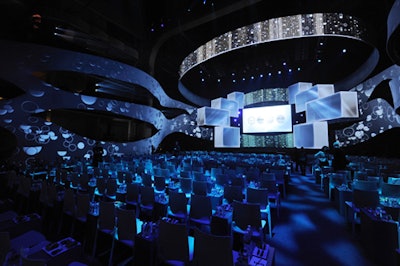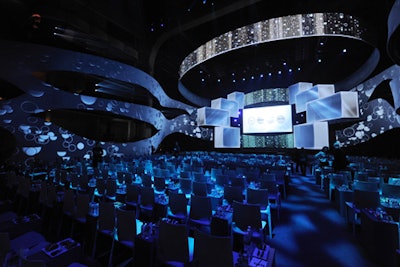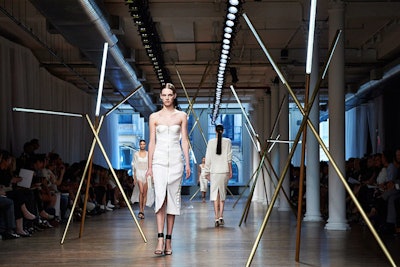
Opting for a more austere and minimal backdrop for his September 6 show at 82 Mercer, Jason Wu worked with Alex de Betak to devise a landscape light show that ran the entire length of the runway. Eight brushed brass light sculptures that emitted a severe white LED light, custom made by show producer and designer Bureau Betak, complemented Wu’s color palette of sandy neutrals infused with gentle shots of color.
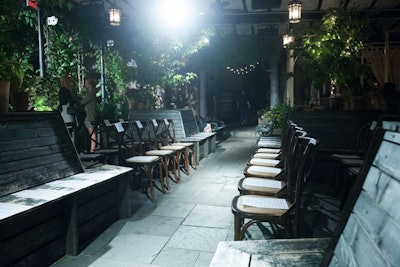
Gallow Green, the alfresco rooftop space atop the McKittrick Hotel, served as the venue for Billy Reid’s charming September 6 men’s show. The rough-hewn garden-cum-abandoned rail yard was an ideal backdrop to the designer’s Southern prep-meets-surf lineup. In a novel twist, a stretch of on-site railroad track, covered in lush greenery, served as the main runway for photographers.
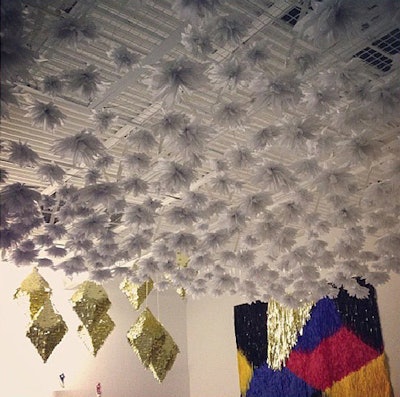
Converse celebrated its newest collaboration—this time with Paris-based fashion house Maison Martin Margiela—with a party at the blank canvas Swiss Institute in SoHo that coupled the avant-garde with classic Americana. Produced by Black Frame, the creative vision of the September 11 launch was around the notion of “reveal,” which collectively served as the evening’s centerpiece—also tying in elements from Confetti System to create bespoke elements like piñatas and a 14- by 15-foot fringe backdrop celebrating the collection’s youthful spirit. The producers also built one entire wall in order to create craters from which sneakers seemed to “explode."
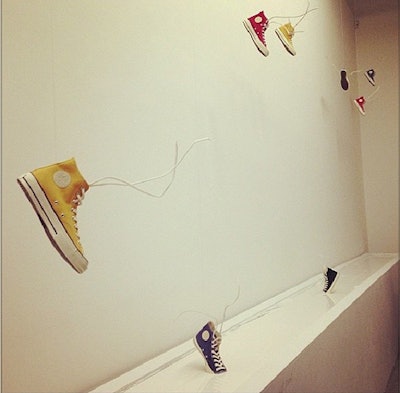
Also creatively done was a large-scale installation whereby a dozen or so classic Converse sneakers were hung by fish line at varying heights—some with toes dipped into a stream of white paint than ran along the wall.
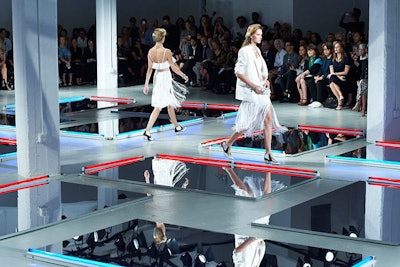
Produced and designed by Bureau Betak, Rodarte's September 11 show at Center548 featured a striking grid of mirrors with red and blue fluorescent tubes (now a Rodarte signature), inspired by Los Angeles’s street grid at night in the '80s. A continuation of its fall collection’s Northern California roots, the West Coast homage further showcases L.A. as a hotbed for talent, as spearheaded by Hedi Slimane.
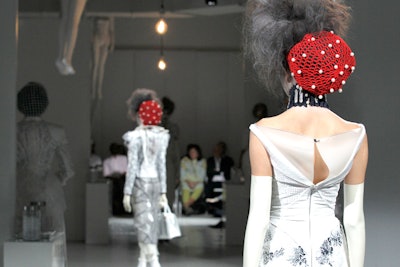
Also held at Center548, Thom Browne’s September 9 show was a lesson in patience and sanity. As guests waited a solid 50 minutes, they were subjected to music-box tinkling in a venue that had been transformed with white padded walls and flickering lights. White female body casts made of plaster gauze hung from the ceiling and positioned around the room created an eerie surreal effect. All in all, it was a true insane asylum experience.
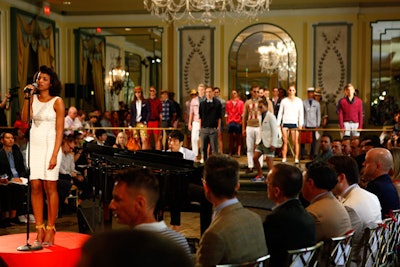
From the invitation to the Pierre hotel show venue, Michael Bastian’s spring collection, shown on September 6, indicated a certain French je ne sais quoi this season. So, although stunning, it was no surprise to enter one of the hotel’s ballrooms to see a grand piano and 220 gilded chairs lined up in half-circular layers. Produced by Stefan Campbell with front of house managed by the Eighth Floor, Bastian’s luxurious event saw a performance by pianist Borahm Lee and accompanying singer Alice Smith.
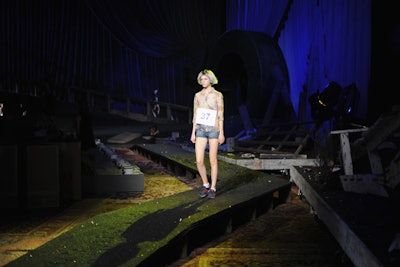
Tasked with realizing Marc Jacobs’s vision of “Victorian surf,” longtime set designer Stefan Beckman devised an abstract beach at the 69th Regiment Armory on September 10 that melded visual cues ranging from the Paul McCartney show at the Park Avenue Armory to Burning Man in Nevada to the notion of artifice. Fully immersing the audience into the runway—a series of six concentric circular islands were built so editors would feel “washed up”—the weeklong load in marked the first time Jacobs had utilized all 25,000 square feet of the venue for a show.
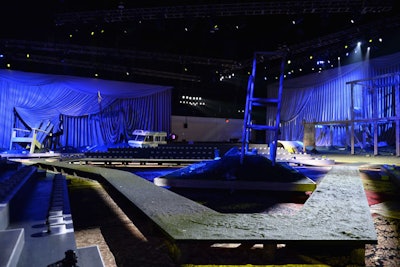
Meandering paths covered with seven tons of coal slag snaked around the entire space of the Marc Jacobs show, with Kadan Productions culling 5,600 yards of fabric for the theatrical stage curtains for an air of opulence. Creative Engineering built the giant props.
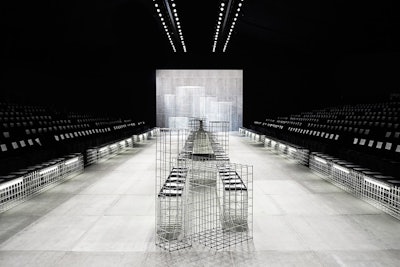
For designer Felipe Oliveira Baptista, the simple lines of a tennis court not only inspired the designs he showed for spring, but also the atmosphere of his September 7 show. Held in the Mercedes-Benz Fashion Week tents at Lincoln Center, the runway backdrop included a series of strategically placed all-white metal tennis nets, which also ran the length of the runway interspersed between guest seating areas.
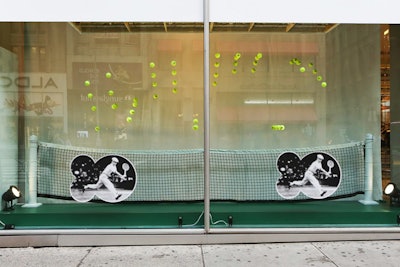
With its 80th birthday on the calendar, Lacoste celebrated the anniversary with a Fifth Avenue flagship window display that continued the fashion show theme of touting a modern take on its heritage. Produced by M Crown Productions, one dedicated interactive window featured kinetic and sound vibration technology where people walking past the window would set off a sensor, triggering a soundtrack of a tennis match and literally affecting the motion of the tennis balls. United Kingdom-based company Feonic was enlisted to provide its device that sticks to the window glass and transmits sound via waves, thus eliminating wires and speakers. A behind-the-scenes look at the making of the windows can be found here.
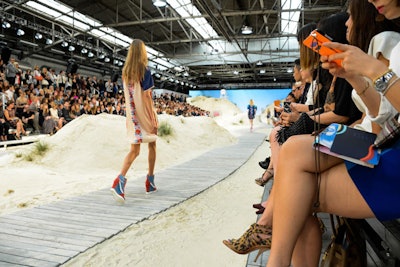
In keeping with the spring collection’s “California style—Melrose to Malibu” theme, the September 9 Tommy Hilfiger show at Pier 94 featured a 390-foot-long weathered wooden boardwalk-cum-runway that was flanked by 140 tons of sand trucked in from Long Beach Island, New Jersey. Produced by KCD, the foundation of the expansive set was constructed primarily of steel decking and then covered in sand. Guests sat on metal bleachers, with mountainous dunes appearing at the far end of the runway, along with surfboards propped up for effect.
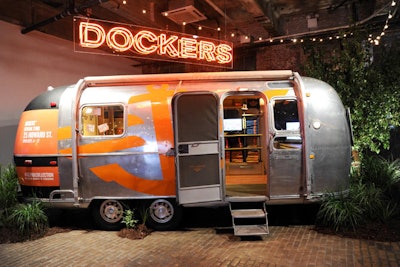
For the Dockers Alpha Collection party held at the start of New York Fashion Week on September 5, BMF Media managing creative director Nicky Balestrieri turned the Highline Stages venue in the meatpacking district into a slice of “cool San Francisco” as a nod to the brand’s roots. A classic Airstream trailer, filled with Dockers pants, sat in one corner while nautical dock ropes lined the guest check-in area. The stage and bar were fashioned from reclaimed wood. Food was also served in a festive manner, with a wheelbarrow full of oysters and a foldout accordion that held a 16-foot-long sushi roll held up by three waiters.
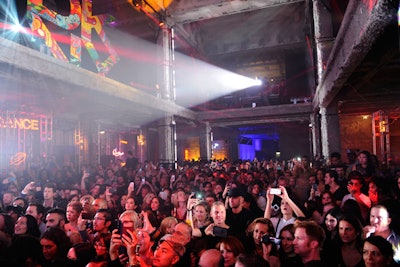
To celebrate its 25th anniversary, DKNY hosted something of a rager on September 9 at 23 Wall Street. The event featured live performances by Rita Ora, Iggy Azalea, A$AP Rocky, and A$AP Ferg.
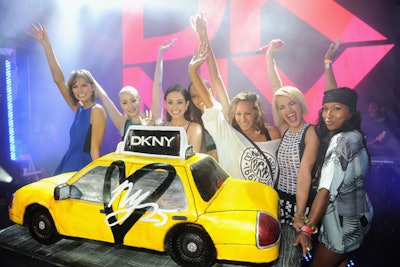
The DKNY's bash, produced by One Kick L.L.C., was filled to capacity with several hundred guests. At the end of the night, emcees Karlie Kloss and Joan Smalls presented a larger-than-life DKNY birthday cake in the shape of an iconic New York City taxicab to Donna Karan while Ora and Melanie Fiona sang “Happy Birthday.” DJ sets by Sinatria and May Kwok had guests dancing late into the night.
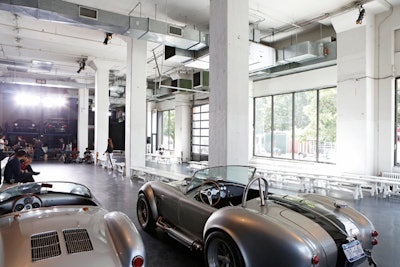
Held within the intimate confines of the Classic Car Club on Hudson Street, General Idea's September 6 show cleared all but two of the venue’s antique roadsters that set the tone for the label’s sleek and sportive separates. General Idea designer Choi Bumsuk, however, wasn’t the only one who was bit by the auto bug during Fashion Week; Siki Im’s show on September 9 featured Range Rovers and BMWs that lined the grit-covered brick walls of Pier 57.

For Opening Ceremony’s first-ever fashion show, held September 8 at the SuperPier off the West Side Highway (a.k.a. Pier 57), producer HK Media Group brought in 20 exotic sports cars from Broadway Supercars and staged their entrance with 34 female and 20 male models. The models were in the cars as they drove onto the massive show space—directly adjacent to where Opening Ceremony launched its “BTW” pop-up market—an homage to New York, where the company was born, but also a nod to the street racing culture of the co-founders’s Los Angeles roots.
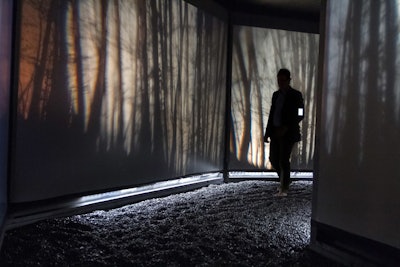
Nike erected a three-day installation in Gansevoort Plaza during Fashion Week to celebrate the launch of its Nike Free Hyperfeel running shoe. Produced by Aramique Krauthamer, founder of production company Odd Division, which specializes in interactive and immersive media, and Web and installation creator Jeff Crouse, the black-on-black temporary structure featured a tactile labyrinth comprising barefoot experiences that amplified nature. Three distinct physical spaces made up the labyrinth, which replicated common running surfaces like stone, sand, and grass. Equipped with neuro-headsets, visitors produced their own audiovisual installation—informed in real time by the brain's sensory reaction to the textures underfoot.
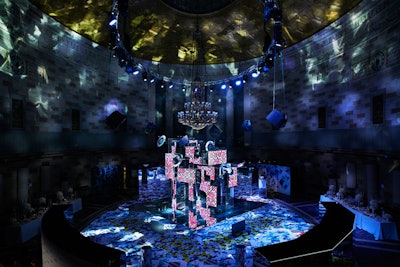
For the launch of its fashion collaboration with the British-designed Peter Pilotto label, Target tapped Bureau Betak to produce back-to-back parties with co-host Net-a-porter.com in London and New York. The latter fête and private shopping night took place on February 6 at Gotham Hall, where 700 guests were immersed into a world of print and color that represented the Pilotto aesthetic. The focal point was a kinetic installation that combined synchronized music, light, video projection, and LED screens. A bevy of models wearing the collection walked the centrally placed mirrored runway at timed intervals during the event while attendees were encouraged to use social media through Instaprint stations using the #PeterPilottoforTarget hashtag. Two stylish English buffets anchored the space.
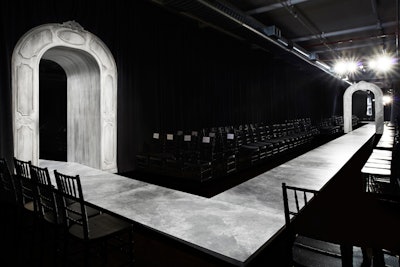
For Jason Wu’s fall show, held February 7 at 82 Mercer in SoHo, Bureau Betak shrouded the usually light-filled massive loft space with black drapes and chairs that strikingly juxtaposed the stark, marble-like runway and entrance arches. “Intimate, classic, but with a touch or surrealism,” said Alex de Betak of the set, which complemented a more reserved show that emphasized all things covered-up.
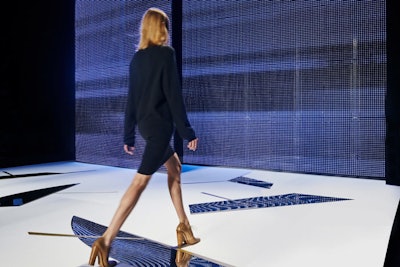
Similar to Jason Wu’s venue, the Lacoste show also contrasted a black show space with, in this case, a gleaming white runway and front row seating. Held at the largest tent space at Mercedes-Benz Fashion Week at Lincoln Center and produced by Bureau Betak, the February 8 show featured a backdrop of two large video walls that played a digital journey to Chantaco, France, home to the world famous golf club in Saint-Jean-de-Luz. The imagery was in the large mirrored shards that were “strewn” on the runway. “The modern images were in contrast to the more classical collection,” de Betak said.
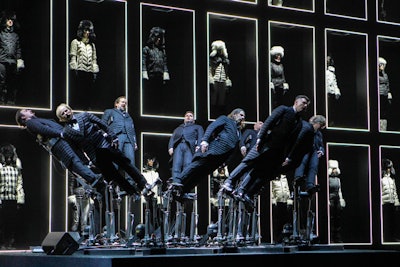
If there’s a large-scale venue in Manhattan, chances are Moncler has used it. For its February 8 Moncler Grenoble presentation, the high-fashion Italian skiwear brand took over the Hammerstein Ballroom to stage a Villa Eugenie-produced extravaganza. The event boasted 10 opera singers from the Pendulum Choir on oscillating pendulums that swayed as they sang in front of a stack of 60 illuminated boxes, each containing a model wearing an outfit from the fall collection. The nearly half-hour performance had a mandate to start on time in order to allow editors to make the dash across the East River to catch the Alexander Wang show.
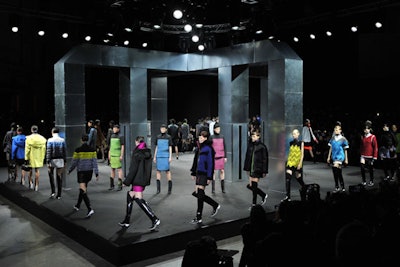
In a radical move that tested both the limits of how far editors would travel and their patience for utter venue gridlock, Alexander Wang staged his February 8 show at the Duggal Greenhouse in the Brooklyn Navy Yard. The venue, which advertises the latest in “solar energy, organic air purification, and eco-friendly building practices,” provided an apt setting for the Prodject-produced show that riffed on extreme conditions and survival. In a clever, high-tech finale, the lights went down and a dozen models walked out, taking their places around the edge of the runway. As the inner circular runway started and stopped, the heat-activated leather clothes on the models stationed in front of the set's metal vents changed colors—from black to blue or from yellow or purple—then slowly faded as they rotated away. Stefan Beckman designed the set.
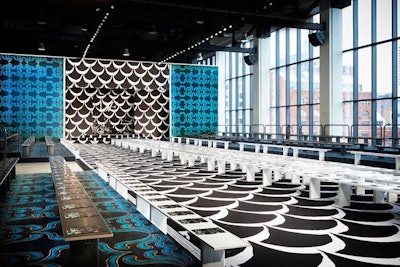
Diane von Furstenberg took a one-season respite from Lincoln Center, decamping to Spring Studios for her February 9 show, which celebrated the 40th anniversary of her iconic wrap dress. Produced by Bureau Betak, the venue was best summed up in one word: bold. Bold prints and graphics complemented the venue’s soaring windows showing the Manhattan skyline. A performance by singer St. Vincent accompanied the show, which suffered from only one downside: the move in venue meant a reduction of several hundred seats.
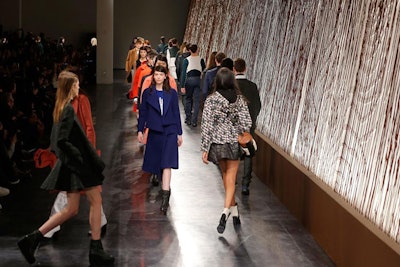
Held on the eve of yet another snowstorm, the February 9 Opening Ceremony show saw Spring Studios transformed by Villa Eugenie into a scene reminiscent from Willy Wonka and the Chocolate Factory. Invitations came in the form of golden tickets and, as guests arrived for one of two shows, they were handed boxes of chocolate made by chocolatier Callebaut. The highlight of the chocolate-filled evening and a nod to Belgium—the European nation that is the retailer’s country of focus for 2014—was a runway backdrop made from 2,000 pounds of melted chocolate poured down a blank white wall. To cap things off, mugs of hot chocolate were passed out to guests as they exited back out into the frosty weather.
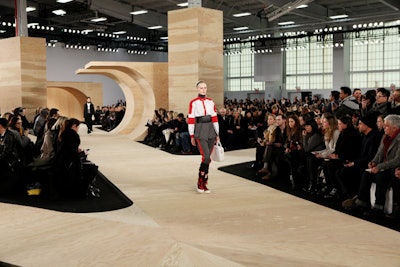
With a new design team at the helm working alongside Marc Jacobs, the Marc by Marc Jacobs symbolically moved from its usual 69th Regiment Armory venue to Pier 36 for its February 10 outing. Producers KCD took the 25,000 square feet of show space and turned it into a conceptual BMX track complete with loop tracks and a full plywood runway and seating for more than 650 guests. Regular Marc Jacobs show vendors returned, including scenic designers Kadan Productions, sound company ADI, and lighting provider IMCD.
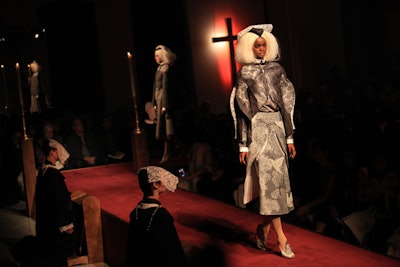
For his fall show on February 10, Thom Browne transformed Center548 in west Chelsea into a church filled with pews, burning incense, illuminated oversize crosses, and fashionable alter boys. Produced by Villa Eugenie, models dressed as chic nuns—with sharp eyebrows, dip-dyed black nails, and white veils—took the runway in a nearly monochromatic collection.
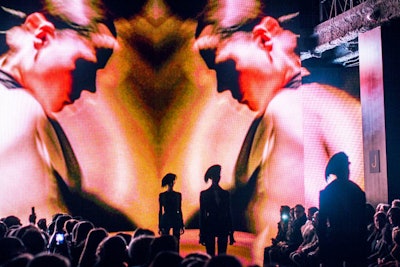
Celebrating all things New York, Donna Karan staged her 30th anniversary show in the financial district, taking over the former J.P. Morgan headquarters at 23 Wall Street. The highlight of the February 10 show, produced by One Kick for 580 seated guests, was a media installation. In the stark and dark venue, a film by Steven Sebring played throughout and was designed to capture the essence of "A Woman in Motion.”
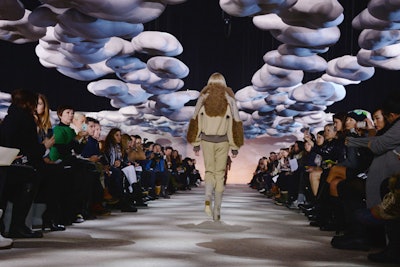
On February 13, Marc Jacobs capped off a snow- and ice-filled Fashion Week schedule with a palate cleanser of a show evident immediately from the 500 individually hung soft sculpture clouds—hung at two different points and slightly altering heights—encased in stretch-jersey-covered foam. “We played with the idea of having a ceiling or things hanging overhead to give the room a more intimate feeling,” said set designer Stefan Beckman (KCD produced the show). A “spoken soundtrack” featuring Jessica Lange reciting “Happy Days Are Here Again” evoked a mood, “giving it a strangeness under the ominous clouds,” Beckman added. Complementing the clouds at the 69th Regiment Armory were 630 individual circular seats made of cut upholstery foam laid out in a grid over 16 rows across 20,000 square feet. Flooring was felt pad with a carpet underlay. All materials were recycled following the show. Naturally, with overhead obstructions, Beckman noted that lighting was challenging and crucial especially given the overhead cover. “Lighting designer Joe Saint did an amazing job of maintaining the mood we needed but also ensuring the girls looked great and not too dark."
